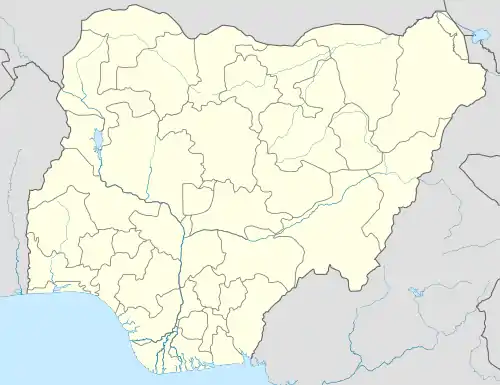Ugwuele
Ugwuele is an Igbo community in Uturu, Isuikwuato Local Government Area, Abia State in Nigeria which houses a stone age site that provides evidence that humans inhabited the region as far back as 250,000 years ago. It was the largest handaxe factory in Nigeria, and possibly in the world.[1][2]
Ugwuele | |
|---|---|
Archaeological site | |
 Ugwuele | |
| Coordinates: 5°51′21″N 7°30′43″E |
Ugwuele civilization
The site at Ugwuele-Uturu, which lies on a dolerite ridge, was excavated between 1977 and 1981.[3] Archaeologists were led to the site by local people who were aware of the unusual artifacts to be found.[4] The northern end of the site held a huge accumulation of stone-age artifacts up to 6 meters in depth.[3] There was no pottery and no polished stone tools, but there were triangular preforms for bifacial tools as well as many flakes and some cores. Handaxes, mostly broken, accounted for four out of five of the tools, and there were also cleavers, picks and sidescrapers. Based on this mix, the site has been classified as Acheulean. It is possible that these tools were rough or unsuccessful attempts, and the successful tools were carried elsewhere to be refined further.[3]
There are three layers of occupation. The oldest and lowest holds quartz flakes, small stone tools and points. Above that is a layer with hoe-like tools, polished stone axes, red ochre, bored stone and red pottery. The top level, with dates between 2935 BC and 15 AD, held grey pottery wares.[5]
The Ugwuele stone workshop site consists of a dolerite ridge with a virtual scree forming its northern end.[3] Sources claimed that the Ugwuele settlement was populated by the ancestors of the lower Niger and West African peoples and they achieved a distinct Stone Age level civilization based on agriculture.[6] These were hominids associated with Homo erectus and the earliest Homo sapiens, who are believed to be hunter-gatherers.[7] Ugwuele experienced cultural developments, demonstrating advances in the arts and religion, which featured the worship of a God creator and intermediary spirits.[6] The Ugwuele hand ax is also particularly notable for archaeologists since it resembled the same tool found in the Acheulean sites, which emerged in France, England, India, and North Africa.[8]
References
- E. Elochukwu Uzukwu (1997). Worship as body language: introduction to Christian worship : an African orientation. Liturgical Press. p. 92. ISBN 0-8146-6151-3.
- Ikechukwu Joshua Okonkwo, Umuagi kindred, Ugwuele
- Ian Shaw, Robert Jameson (1999). "Ugwuele-Uturu". A dictionary of archaeology. John Wiley and Sons. p. 594. ISBN 0-631-17423-0.
- Henry Cleere (1984). Approaches to the archaeological heritage: a comparative study of world cultural resource management systems. Cambridge University Press. p. 107. ISBN 0-521-24305-X.
- Sabinus Iweadighi. "Origin or Genealogy of the Igbo people of Nigeria" (PDF). University of Vienna. Retrieved 2011-01-09.
- Eneze, Reuben (2016). Igbo Culture. Bllomington, IN: AuthorHouse. ISBN 9781496967473.
- Oriji, John (2011). Political Organization in Nigeria since the Late Stone Age: A History of the Igbo People. Hampshire: Palgrave Macmillan. pp. 28. ISBN 9781349383696.
- Acholonu, Catherine (2013). Eden in Sumer on the Niger: Archaeological, Linguistic, and Genetic Evidence of 450,000 Years of Atlantis, Eden and Sumer in West Africa. Wuse Abuja: Chinazor Onianwah. p. 85. ISBN 9789789102594.
